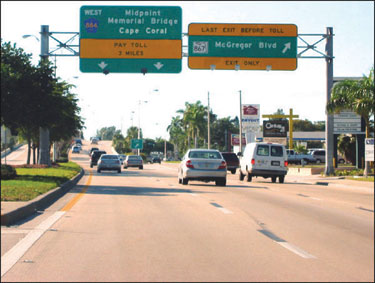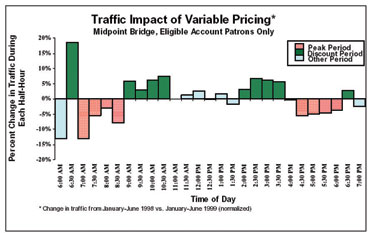Lee County Variable Bridge Tolls - Lee County, FL
FAST FACTS ABOUT: Lee County Variable Bridge Tolls
Types of TDM: Value Pricing, Off-peak Travel Time Shift
Keywords: Value pricing, variable pricing, electronic
tolling, flexible work arrangements, off-peak travel time shift, discounts,
incentives
Area Demographics: Lee County, Florida (Cape Coral
and Fort Myers); 400,000 residents
Program: 50 cent discounts on tolls for use of off-peak
travel times on two principal bridges accompanied action to raise overall
bridge tolls to $1 (from 75 cents)
Cost of Program: $9.7 million grant awarded by Federal
Highway Administration for technology installation, demonstration, implementation,
and evaluation; additional $7.0 million set aside as “emergency
revenue reserve”
Implementer: Lee County Public Works
Results: 5% shift from peak to off-peak travel
Contact: Chris Swenson, CRSPE, Inc., crs@crspe.com

Providing Choice in Tolling
Lee County, Florida, is a pioneer in using variable tolls as a way to
manage congestion, provide traveler choice, and spread traffic away
from the peak period. The principle behind this objective is that commuters
will make rational choices if those decisions are based on balanced
cost incentives. The Leeway project provides another measure of choice
– price choice – to the mix of Transportation Demand Management
(TDM) strategies.
Background
Lee County is located in southwest Florida. Approximately half a million
people live in the metropolitan area comprised of Ft. Myers and Cape
Coral, with an additional 1.7 million tourists visiting per year. The
Caloosahatchee River separates these two cities, and the County provides
only three bridge crossings. Two of these crossings, the Cape Coral
Bridge and the Midpoint Bridge, are the most relevant to commuter traffic,
and were the focus of the Variable Pricing Program.
A toll of $1.00 was levied on both bridges in 1997. In order to convince
the public to accept the higher $1.00 toll, over a previous $0.75 toll,
Lee County Commissioners endorsed an innovative concept of varying the
level of the toll based upon the time of day. In the “shoulders
of the peak period” (6:30 – 7:00 am, 9:00 – 11:00
am, 2:00 – 4:00 pm, and 6:30 – 7:00 pm), patrons received
a 50 percent discount on the toll if they utilize the bridge’s
electronic toll collection (ETC) system. Due to a popular “frequent
user” program, this discount varies in value from either $0.25
to $0.50 each trip.
The objectives of the variable pricing program were to provide travelers
with:
• an incentive to shift from peak periods
• an opportunity to lower out-of-pocket costs
• a reason to use ETC (which provides for better traffic management
at toll plazas)
Challenges
There are a variety of challenges involved with the variable pricing
program. The two principal concerns were:
• marketing the benefits of variable pricing in an area with relatively
low levels of congestion, and,
• ensuring sufficient funds are generated to repay bonds and cover
operating/maintenance costs
Lee County does not experience significant levels of congestion. In
fact, most of the main arterials and highways operate at free-flow even
in the peak hour. The challenge to Lee County officials was how to market
the new off-peak travel discounts, when shifting travel was not likely
to significantly short the likely travel time. Lee County responded
to this challenge by marketing the convenience of electronic tolling
and the cost savings provided by using off-peak periods. A variety of
media was used to market the service, with multiple points of presence
throughout the County. Media coverage of the concept also was high,
since there is appeal in the innovation of variable pricing. Within
a year, the project had over 40 articles in print media and 150 news
stories in televised media.
In addition to convincing travelers to use the program, Lee County also
needed to convince employers to offer employees flexible scheduling
and variable work hours. Without the ability to shift the commuter’s
travel time, the off-peak discount program would not be successful.
In order to accomplish this, the County conducted outreach to medium
and large size businesses in Ft. Myers (the principal employment node).
The issue of ensuring sufficient funds was critical to implementing
the program. In 1996, Lee County applied for, and received, a grant
from the Federal Highway Administration’s Value Pricing Pilot
Program. The $20 Million grant provided a $7 Million set-aside to compensate
for lost tolls under the variable pricing program. The set-aside was
necessary to alleviate concerns about the potential loss of revenue.
Results
The variable pricing program has been successful in meeting the program’s
objectives. Approximately 7 percent of all eligible participants indicate
the variable pricing program causes them to alter their tripmaking behavior.
According to a telephone survey of eligible drivers in late 1999, half
of respondents indicated they always or sometimes considered the discounts
prior to making a trip across the bridges. Finally, the variable pricing
program is well known in Lee County, with over 90 percent of travelers
familiar with the program. Altogether, these show that travelers are
aware of and consider the option provided to them from the variable
pricing program.
In three years of the implemented project, as reported by Mark Burris
at the Center for Urban Transportation Research (“Lee County Variable
Pricing Project: Evaluation Report”, January 2001), use of the
bridges increased in the off-peak times and decreased during the peak
periods. Traffic data near the bridges indicate that variable pricing
had caused no measurable change in vehicle speeds, queue lengths at
toll plazas, average vehicle occupancy, transit ridership, or accidents.

Over time, more and more travelers have utilized the electronic toll
collection technologies, reducing the average cost per transaction.
Lowered transaction costs on the bridges have partially offset the loss
of revenue from the toll discount, as has the natural increase in daily
traffic. It should be noted that the program continues to this day (September
2003), well after the expiration of the Federally funded toll revenue
guarantee.
___
Evidence for this case study has been provided by numerous evaluation
reports conducted by Mark Burris (Center for Urban Transportation Research)
and Chris Swenson (CRSPE, Inc.).